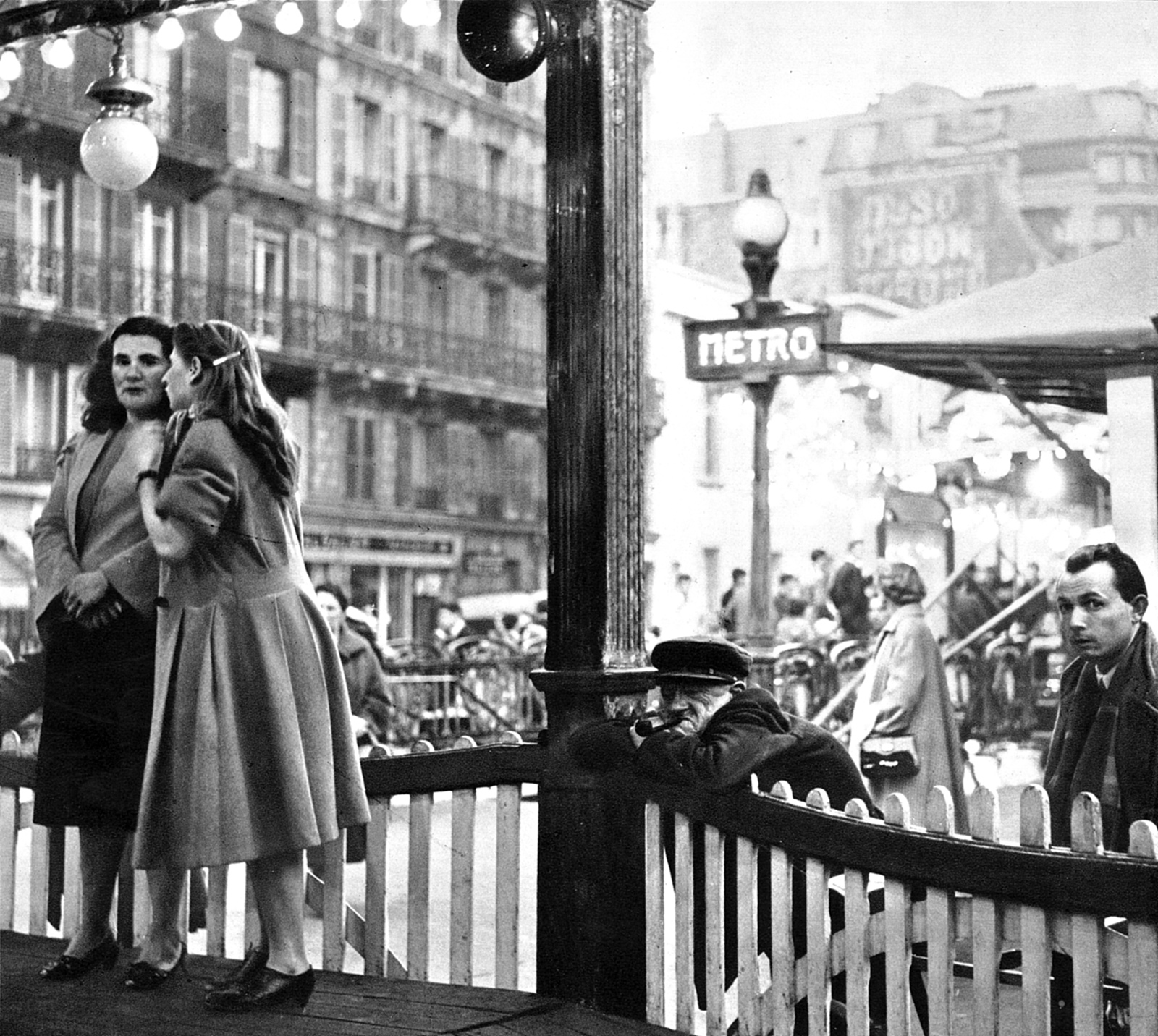Paris Vagabond, first published in 1952, is one of the most extraordinary books ever written about that city.* It follows in the lineage of great narratives by champion walkers—Louis-Sébastien Mercier’s Le Tableau de Paris (1781–1788), Nicolas-Edme Restif de la Bretonne’s Les Nuits de Paris (1788–1794), Alexandre Privat d’Anglemont’s Paris anecdote (1854), Léon-Paul Fargue’s Le Piéton de Paris (1939), among others—although its focus is more pointed and specific. Had a translation come out in the 1960s or 1970s, heyday of budget travel guides, someone might have been tempted to call it “Paris on Nothing a Day.” It is primarily concerned with all the ways in which people managed to survive in the city on no money at all, a way of life shared by Clébert himself. As he told the journalist Olivier Bailly in a 2009 interview:
It was not a reportage but a personal investigation; it was me in the streets of Paris, rediscovering a city that was still as it had been during the Occupation, which is to say that in some ways it was still the pre-war city, that of the Surrealists and of [Pierre Mac Orlan’s concept] le fantastique social, which lived on…. It was a clandestine Paris that I came to know as a clandestine myself.
Clébert was born in 1926 to a bourgeois family (whose identity remains unknown) in the wealthy suburb of Neuilly-sur-Seine and educated in a Jesuit boarding school in Passy, from which he ran away at age seventeen and joined the Resistance. Somewhere along the line he shed his surname and became Clébert, a relatively uncommon name that I can’t help but think he chose because of its proximity to clebs, argot for “dog.” At loose ends once Paris was liberated, he took on a variety of jobs, including hauling produce crates at Les Halles, hawking the newspaper L’Intransigeant, and more colorful employment that he describes in the book, such as the inimitably French and positivistic task of taking measurements of random apartments all over the city.
From there he slid into living as the lilies of the field, who neither toil nor spin. Between 1944 and 1948 he spent time with the ragpickers in the Zone (the roughly thousand-foot-wide ribbon of land that surrounded the city’s former military wall and for a century served as a refuge to marginals of all sorts), with the Roma of the Maximoff clan at Porte de Montreuil, with the surviving Jewish community on Rue des Rosiers (Clébert spoke a bit of Yiddish), with the clochards around Place Maubert and Rue Mouffetard, with hoboes and lamsters and eccentrics and living ghosts all over the city. The whole time he took notes, with any available pencil on any available paper, such as restaurant placemats and bits of newspaper. He kept a sack of these, and when he came to write his book he drew them out one by one at random, the shape of his text thus determined by a venerable Dada chance operation.
He sent his manuscript to Blaise Cendrars, one of his two professed literary forebears (the other was Henry Miller). Cendrars was a pioneering Modernist poet (“The Prose of the Trans-Siberian and of Little Jeanne of France,” 1913), novelist (Sutter’s Gold, 1925; Moravagine, 1926), reporter, librettist, filmmaker, and, perhaps most importantly, the author of a quartet of rollicking, shape-shifting memoirs: The Astonished Man (1945), Lice (1946), Planus (1948), and Sky (1949). That they are adventurous and poetic perhaps at the expense of factuality would not have disconcerted Clébert, whose own book was eventually described in a review by Georges Arnaud (author of The Wages of Fear) as “a travel narrative in which everything is true, even the legends. And what of it?” And while Clébert’s long, rolling, jangling sentences are akin to Jack Kerouac’s spontaneous bop prosody—the tone of Paris Vagabond eerily prefigures On the Road, for all that Clébert’s book takes place entirely within one city and its only means of locomotion is shoe leather—in fact both Clébert and Kerouac took inspiration from Cendrars, whose sentences can cascade for half a page, veering left and right, dropping introspectively and then rising anthemically, without drawing breath.
Recognizing a literary heir, Cendrars arranged to have Vagabond Paris published by his own house, Denoël. The book was a sensation, and narrowly missed obtaining a major literary prize (four votes for the Renaudot, eight for the Sainte-Beuve). Two years later, the book was issued in a deluxe hardback edition by Le Club du Meilleur Livre, which requested illustrations. Clébert was close to the photographer Robert Doisneau, one of the book’s dedicatees, but couldn’t afford his rates, so he turned to Patrice Molinard, a street photographer he met at the flea market who then lived in a former brothel near the Opéra that had once been frequented by Toulouse-Lautrec. Molinard’s 115 photographs, which to an extent were directed by Clébert, form the perfect visual analog to his text. (The published photos are perhaps roughly executed, but they are all that we have. Molinard destroyed his archives in the late 1960s, so that there are no surviving negatives, and no one has succeeded in locating original prints.)
Advertisement
Vagabond Paris led directly to the publication by Denoël of two other books written by friends of Clébert: Jacques Yonnet’s Rue des Maléfices (1954; originally entitled Enchantements sur Paris; in English translation as Paris Noir), a dizzying chronicle of occult forces along the clochard corridor on the Left Bank during the Occupation; and Robert Giraud’s Le Vin des rues (1955), an affecting survey of clochard life in Paris. The three books are often considered together as a trilogy, a record of the fragile and impoverished but nonetheless incandescent postwar years. Yonnet had been an active Resistance fighter, a reporter (he broke the story of Dr. Petiot, a mass murderer who preyed on Jews during the Occupation), and eventually a chronicler of bistros for L’Auvergnat de Paris, a trade journal. Rue des Maléfices was his only book. Giraud, who had also been in the Resistance, was an inveterate barfly, sporadically a bouquiniste on the quais, and eventually a prolific author of books, some of them in collaboration with Robert Doisneau, such as his pioneering study of tattooing (1950), and many on the arcana of argot, a subject on which he was a recognized expert. The three along with Doisneau hung out frequently at Chez Fraysse on Rue de Seine, the local café of Jacques and Pierre Prévert, the antiquarian Romi, and many other raffish personalities of the period.
Clébert also spent time a few streets away at Chez Moineau, a much cheaper establishment that attracted penniless bohemian youths and was documented by the Dutch photographer Ed van der Elsken in his fictionalized chronicle Love on the Left Bank (1956). Among the habitués was Jean-Claude Guilbert, who appears in Paris Vagabond as “the Shepherd” and who went on to act in Robert Bresson’s Mouchette and Au hasard Balthazar. Also frequently present were Guy Debord, Michèle Bernstein, Gil J. Wolman, Ivan Chtcheglov, and the other members of the Lettrist International. Although Debord never made any written mention of Clébert or his book, his half-brother, Patrick Labaste, told Debord’s biographer Christophe Bourseiller (Vie et mort de Guy Debord, 1999) that Debord had “loved” Paris Vagabond. And although Bernstein told Bourseiller that the word “psychogeography” had first been uttered by a North African with whom they smoked kif at a café on Rue Xavier-Privas, it is notable that that concept and its twin, that of dérive, or “drift,” both entered the Lettrist vocabulary after the publication of Clébert’s book.
In fact the circumstantial evidence is strong that Debord drew from Paris Vagabond the whole idea of the drift, defined as
a technique of forward movement through a variety of ambiances…. One or several persons, giving themselves over to the drift for a period of variable length, dispense with the usual reasons for moving about, and with their relationships, jobs, and leisure activities, in order to let themselves follow the pull of the landscape and the encounters that come from it.
This sounds like nothing so much as a description of Clébert’s book, even if Debord later credited Thomas De Quincey and his Confessions of an English Opium Eater, with its account of night wanderings in London, as the inspiration for the drift. And how else but by way of Paris Vagabond would the Lettrists have come to know of the obscure and remote Rue Sauvage, the destruction of which is mourned in the seventh issue (August 3, 1954) of the Lettrist International organ Potlatch?
A year after Paris Vagabond Clébert published a sort of companion volume, La Vie sauvage (1953), that sets him adrift in the countryside, a lovely book that has sadly never been reprinted. He wrote a few largely uninspired texts on Paris—a photo book aimed at tourists, again with Molinard but to quite different effect; an update of a 1910 walking tour by the Marquis de Rochegude—and was courted by the major magazines of the period. But he was sick of city living and made his way down to the mountainous Lubéron region of Provence, which was dotted with abandoned stone villages, in one of which he lived for a decade without running water or electricity.
In 1968 he moved to Oppède-le-Vieux, a ghost village turned into a sort of artists’ commune during the war, where his neighbors included the American photographer Alexey Brodovitch and Consuelo de Saint-Exupéry, widow of the aviator. He spent the rest of his life there. He wrote thirty-three books in all, many on the history and lore of Provence, his most celebrated volume being Les Tziganes (1962), published in English the following year as The Gypsies, which is arguably the finest work for a general audience on the subject. He died in Oppède on September 20, 2011.
Advertisement
-
*
This essay will appear in somewhat different form as the introduction to a new translation of Paris Vagabond by Donald Nicholson-Smith, to be published by New York Review Books in April. ↩



